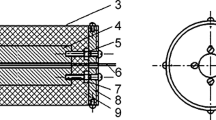Abstract
Carleton University’s experimental atrium and tunnel facilities share a fan chamber and three large exhaust fans. Using oxygen consumption calorimetry, the Heat Release Rates (HRR) of fires in either of these facilities can be calculated. This paper focuses on the design of the instrumentation in the fan chamber, which was carried out using the Fire Dynamics Simulator (FDS) and manual velocity measurements. Due to a high amount of mixing and turbulence and a long travel distance, the temperature and gas concentration profiles are relatively uniform. However, for the same reason, the velocity profile had to be looked at very closely to find an optimum combination of bi-directional probes. The analysis indicated that acceptable HRR measurements can be obtained using an array of six thermocouples, four bi-directional velocity probes and a gas sampling grid. Results from the preliminary tests are presented. The system shows a reasonable estimate of the HRR as compared to the propane calibration burner.











Similar content being viewed by others
References
Bryant R et al (2004) The NIST 3 Megawatt quantitative heat release rate facility—description and procedures. NISTIR 7052
Huggett C (1980) Estimation of the rate of heat release by means of oxygen consumption. Fire Mater 4:61–65
Thornton W (1917) The relation of oxygen to the heat of combustion of organic compounds. Philos Mag J Sci 33:196–203
Parker W (1984) Calculations of the heat release rate by oxygen consumption for various applications. J Fire Sci 2:380–395
Babrauskas V (1984) Development of the cone calorimeter—a bench-scale heat release rate apparatus based on oxygen consumption. Fire Mater 8(2):81–95
Stroup D, DeLauter L, Lee J, Roadarmel G (2000) Large fire research facility (Building 205) Exhaust hood heat release rate measurement system. NISTIR6509. National Institute of Standards and Technology
Tewarson A (2002) Generation of heat and chemical compounds in fires. In: The SFPE Handbook of fire protection engineering, 3rd edn. The National Fire Protection Association Press, Quincy, MA, pp 3-82–3-161
Janssens ML (1991) Measuring rate of heat release by oxygen consumption. Fire Technol 27:234–249
McGrattan KB, Klein B, Hostikkia S, Floyd J (2007) Fire dynamics simulator (Version 5): user guide. NIST SP 1019-5, NIST Special Publication 1019-5. National Institute of Technology and Standards
ASHRAE Handbook, Fundamentals (1993) American Society of Heating, Refrigeration, and Air-Conditioning Engineers, Atlanta, GA, pp 13.14–13.15
McCaffrey B, Heskestad G (1976) A robust bidirectional low-velocity probe for flame and fire application. Combust Flame 26:125–127
Michel R (2009) Development and calibration of heat release rate measurement system for an experimental atrium. Mater Thesis, Carleton University
Author information
Authors and Affiliations
Corresponding author
Rights and permissions
About this article
Cite this article
Ko, Y.J., Michels, R. & Hadjisophocleous, G.V. Instrumentation Design for HRR Measurements in a Large-Scale Fire Facility. Fire Technol 47, 1047–1061 (2011). https://doi.org/10.1007/s10694-009-0115-7
Received:
Accepted:
Published:
Issue Date:
DOI: https://doi.org/10.1007/s10694-009-0115-7




